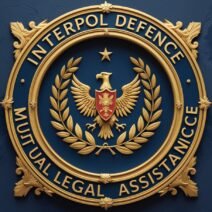Cybercrime does not respect national borders. A hacker in one country can easily target victims in another. They often use computers located in a third country. This creates a big problem for police. The evidence they need, like server logs and email records, usually sits in a foreign nation. Mutual Legal Assistance (MLA) is the legal solution. It is the official way to get this digital evidence for court.
This 2025 guide explains how to use MLA for cyber cases. We focus on the special steps for digital evidence. We cover cloud data, encryption, and legal rules. This guide helps police, lawyers, and investigators solve online crimes globally.
💻 Why Cybercrime Makes MLA Tough
Digital evidence has unique features that complicate the MLA process.
- It Disappears Quickly: Digital data can be deleted in seconds. The slow MLA process can conflict with the need for speed.
- Jurisdiction is Unclear: Data in the cloud often spreads across many countries. This creates confusion over which laws apply.
- Local Storage Laws: Some countries force data about their people to stay inside their borders.
- Company Rules: Big tech companies have their own steps for handling government requests.
📜 The Key Laws for Cyber MLA
Special international agreements help with cybercrime evidence.
- The Budapest Convention on Cybercrime: This is the main treaty. It allows:
- Data Preservation: Asking a company to save data quickly before it vanishes.
- Fast Disclosure: Getting details about a communication’s path.
- Help with Computer Searches.
- Bilateral MLATs: Newer agreements often include specific rules for computer data.
- The US CLOUD Act: This U.S. law lets the government force American companies to hand over data, even if it’s stored overseas. This can be faster than MLA in some cases.
📋 Step-by-Step: Getting Digital Evidence with MLA
Follow these clear steps for a successful request.
Step 1: Find and Secure the Evidence
- First, identify the exact data you need (e.g., IP address logs, user account details).
- Then, use the Budapest Convention to ask the foreign country to tell the company to preserve the data immediately. This stops it from being deleted.
Step 2: Write a Very Clear Letter of Request
Your request must be specific. Vague requests fail.
- Good Example: “We request the subscriber name and IP logs for the email account ‘user@example.com‘ from [Service Provider] for March 2024.”
- Bad Example: “Please send all data for the user.”
Step 3: Say How You Want the Data
Tell them how to send the evidence to keep it reliable.
- Ask for the data in its original format.
- Request all metadata (like timestamps).
- Require a proof of authenticity letter from the company or foreign government.
Step 4: Send and Follow Up
Give the request to your Central Authority. If the case is urgent, explain why you need fast action.
⚠️ Common Problems and Smart Solutions
- Problem: The Company is in a Different Country.
- Solution: Send the MLA request to the country where the company has its main headquarters.
- Problem: Encrypted Messages.
- Solution: MLA often cannot break encryption. Instead, focus on getting metadata (who talked to whom and when) or try to get the suspect’s device.
- Problem: Conflicting Laws like the CLOUD Act.
- Solution: This is complex. Companies might get mixed orders. New international deals are trying to fix this. Always ask your Central Authority for advice.
🔍 Real Example: Stopping a Business Email Scam
The Crime: A UK company lost £1 million to a fake email scam. The money went to a bank in Cyprus. The fake email came from a U.S. web hosting company.
The MLA Action:
- Request to the USA: The UK police sent a precise MLA request to get the user details and IP logs from the U.S. web host.
- Request to Cyprus: Another request asked Cyprus to freeze the bank account and get transaction records.
- The Result: The U.S. data identified the hacker. The Cyprus data tracked the money. The case was solved.
🔮 The Future: Faster and Direct Cooperation
The system is improving for the better.
- Direct Requests: Laws like the CLOUD Act allow some direct requests to companies, skipping slow government channels.
- Digital Systems: Countries are now using online platforms to send and track MLA requests, which makes everything faster.
❓ Cybercrime MLA FAQs
Q1: Can we get data from Facebook or Twitter with MLA?
Yes. You must send the MLA request to the United States, where these companies are based. Provide specific account details.
Q2: What’s the difference between saving data and getting data?
Saving data is an emergency hold to prevent deletion. Getting data is the formal process to receive that saved information for your investigation.
Q3: How long does cyber MLA take?
It can be faster than other MLA types if you use the right treaties. Simple requests may take 4-6 months. Complex cases can take over a year.
Q4: What if the data country didn’t sign the Budapest Convention?
You must use a standard bilateral treaty or ask for help based on reciprocity. The process might be slower.
Q5: Can a private company use MLA?
No. Only government agencies can use MLA. A company must report the crime to local police, who then start the MLA process.
🧭 Conclusion: Be Precise and Patient
Getting digital evidence with MLA requires clear requests and patience. You must be very specific in what you ask for. While the process is slow, it is a powerful tool for fighting global cybercrime. It ensures that online criminals can be brought to justice.
To learn the basics of MLA, read our guide How to Request Mutual Legal Assistance: A Step-by-Step Guide. To make sure your digital evidence is accepted in court, see Cross-Border Evidence & MLA: Ensuring Admissibility.
